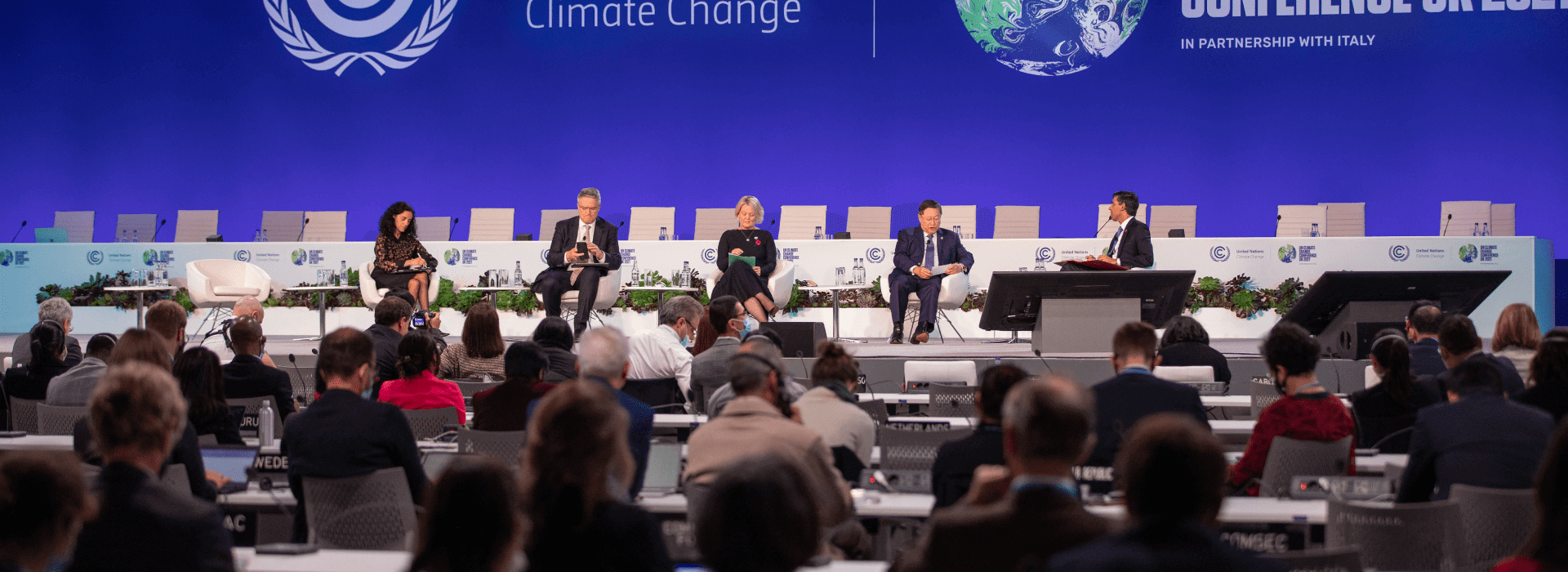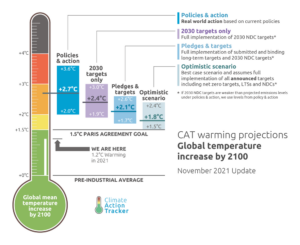
New emissions reduction commitments
The annual U.N. Conference of Parties (COP) meetings are a key global focal point for announcing climate-related pledges, commitments, and declarations. This year’s COP26, which just wrapped up in Glasgow, has proved no different.
For example, Indian Prime Minister Narendra Modi surprised many by committing India to net-zero emissions by 2070, along with announcing a host of other targets for this decade, ranging from increasing renewable energy deployment to reducing the carbon-intensity of India’s economy (the amount of carbon emitted per unit of GDP). Many other countries communicated increased ambition through their Nationally Determined Contributions (NDC) toward achieving the goals of the Paris Agreement, or provided their own net-zero emissions declarations. And the joint U.S.-China declaration reminded us that these two countries recognize the unavoidable importance of spurring each other to take action on climate, even during a period of heightened tension.
Actions weren’t limited to countries; corporations, sub-national jurisdictions, and other non-state actors also announced a host of science-based targets and sector-specific initiatives meant to drive down the greenhouse gas emissions responsible for climate change. Although there were notable areas with insufficient progress, such as on climate finance and the consideration of loss and damage claims, it was clear that overall ambition is on the rise.
How could new commitments impact the climate?
The potential impacts of the new commitments are entirely dependent on if and how they are implemented. Independent analyses by Climate Action Tracker (CAT) and the International Energy Agency (IEA) both found that full implementation of current pledges would most likely result in around 1.8° C of warming. While this would not meet the Paris Agreement’s most ambitious goal of limiting warming to 1.5° C, following through on these pledges would nevertheless be a massive improvement over our current path toward roughly 2.7° C of warming, which scientists agree would be disastrous.

Other analyses, such as an article from researchers at the Pacific Northwest National Laboratory (PNNL) and other leading research institutions, focus on the near-term pledges embedded in the NDCs, and find that achieving those commitments would likely result in roughly 2° C of warming. According to their scenario analysis, if global ambition rises over time, the probability of staying below 2° C rises to 60%, but the chance of staying below 1.5°C is still only 11%. The problem is that we are quickly running out of time to scale ambition.
While these studies broadly agree on the impacts of implementing the pledges, the most important conclusion to draw from them is that there remains a large gap between the rhetorical ambition of these pledges and the implementation of credible policies and actions. Unless we can rapidly translate commitments into real-world emissions reductions, the pledges made at COP26 will end up as nothing more than lip service, as protesters on the streets of Glasgow have warned.
Opportunities for philanthropy
The latest round of ambitious long-term pledges should be a call to philanthropy to immediately begin developing and implementing the policies needed to achieve these targets. Philanthropy and its civil society partners have a critical role to play in kick-starting action today.
As a start, philanthropy should empower civil society to advocate for net-zero emissions targets that follow best practices outlined by CAT and are accompanied by policies that drive near-term actions. While commitments alone don’t achieve results, pledges do send important signals to other countries as well as to subnational and non-state actors. The global transition to a net-zero emissions world is a giant coordination game, and the evidence that higher ambition is becoming the norm will only spur further action and momentum.
Philanthropy and its civil society partners have a critical role to play in kick-starting action today.
A distinguishing feature of recent COPs is the growth of announcements and pledges by smaller coalitions of countries and non-state actors. There are so many multilateral commitments and announcements from these coalitions that this is turning into a parallel process to the official U.N. negotiations. Many of these independent pledges are quite ambitious and will both support the achievement of the official pledges and drive additional action in countries outside of the coalitions. It is here where the groundwork of grantees and philanthropic partners are bearing fruit with announcements in the areas of methane, road transport, shipping, finance, industry, carbon dioxide removal, forests and land use, and many others.
These pledges signal that some segments of the economy are ready for real, transformational change. They reflect back to governments a call for action and have the potential to smooth the passage of more ambitious policies, all the while signaling to investors that there is no shortage of new and growing opportunities, not to mention the transition risks associated with continuing with business as usual.
Conclusion
COP26 generated many new and ambitious climate pledges, and the latest analyses reveal that they could significantly improve our chances of limiting warming to 2° C or below. Whether we can achieve the potential benefits will come down to implementation. However, there is consensus that even these pledges are insufficient for limiting warming to the desired goal of 1.5° C, which would require action to be scaled up further and faster.
The pledges made at COP26 represent substantial improvement over previous commitments, and this is the first time they have been collectively assessed as sufficient to limit warming to 2° C. The increased ambition is heartening, but must be made a reality through implementation. Philanthropy has played an important role in helping drive this ambition, must keep pressing more ambition to reach 1.5° C, and must continue working to ensure that we realize the full potential of past, present, and future commitments.
____
Header image © HM Treasury

